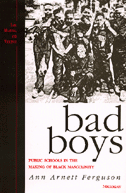Yum. Can I get some butter to go with my heternormative spaghetti please? (This image was pointed out to me by STA.)
Month: August 2010
Oh bother, part 15: mommy gets love, but daddy gets respect
Prepping for class: feminist pedagogies, some sources
So one of my colleagues at the U of M suggested that I focus my feminist pedagogies class this fall on technology. I love this idea–even though it requires a lot of work as I think through what technologies to focus on, etc. Not sure if I even like the term technologies here. Maybe new social media or digital media? Anyway, I want to begin putting together a list of possible resources for the class. Here’s what I’ve already found (most of this comes via my twitter feed). Since I trying to learn a lot more about twitter (I don’t know much, but want to use it in my classes this year), this list is pretty twitter-heavy at this point.
GENERAL TECHNOLOGY SOURCES:
- Reflections on a technology-driven syllabus
- On ethics and responsible writing practices online
- How Racist Language Shapes New Social Media and why you should care
- Young Feminists are Online
TWITTER SOURCES:
- Twitter is a snark valve
- Twitter for academia
- The Art of the Tweet
- 7 tools to make better use of twitter
- Including Twitter profile on movable type (UThink)
I’m still trying to decide how much emphasis I want to put on technology and how many different technologies that I want to focus on. I definitely want to talk about blogging and twitter. I’m also thinking about podcasts/v-logs, google maps/google Earth and digital storytelling. Any thoughts?
Race and troublemakers as future prisoners
 Last week I tweeted about this article from Sociological Images via Racialicous: Framing Children’s Deviances. In her brief analysis/comparison of the media representation of two boys’ (one white, one black) troublemaking joy rides, Lisa Wade references a book that might be important for thinking about how race shapes our understandings and assessments of troublemaking in its various forms: Bad Boys: Public Schools in the Making of Black Masculinity. I checked this book out from the library and just started reading it this afternoon. From what I have read so far, I think that Ann Arnette Ferguson could offer some important insights on how we discipline children and shape/regulate/distort their expressions of troublemaking.
Last week I tweeted about this article from Sociological Images via Racialicous: Framing Children’s Deviances. In her brief analysis/comparison of the media representation of two boys’ (one white, one black) troublemaking joy rides, Lisa Wade references a book that might be important for thinking about how race shapes our understandings and assessments of troublemaking in its various forms: Bad Boys: Public Schools in the Making of Black Masculinity. I checked this book out from the library and just started reading it this afternoon. From what I have read so far, I think that Ann Arnette Ferguson could offer some important insights on how we discipline children and shape/regulate/distort their expressions of troublemaking.
Check out what she has to say about trouble and the purpose of her study:
But trouble is not only the site of regulation and stigmatization. Under certain conditions it can also be a powerful occasion for identification and recognition. This study investigates this aspect of punishment through an exploration of the meaning of school rules and the interpretation of trouble from the youth’s perspective. What does it mean to hear adults say that you are bound for jail and to understand that the future predicted for you is “doing time” inside prison walls? What does school trouble mean under such deleterious circumstances? How does a ten-year-old black boy fashion a sense of self within this context (2-3)?
I really like how she doesn’t just theorize about how schools “create, shape and regulate” students’ social identities, but she also discusses the agency of the students and their participation in and resistance to schools’ rules and regulations (2). I can’t wait to read more.
Oh bother, part 14: free to be you and me…with target?
I was just channel flipping between a Travel Channel show featuring chicken-fried bacon and House Hunters on HGTV, when I saw this very disturbing ad:
This makes me sad, especially in light of this recent blog article on city pages. And it really, really bothers me.


